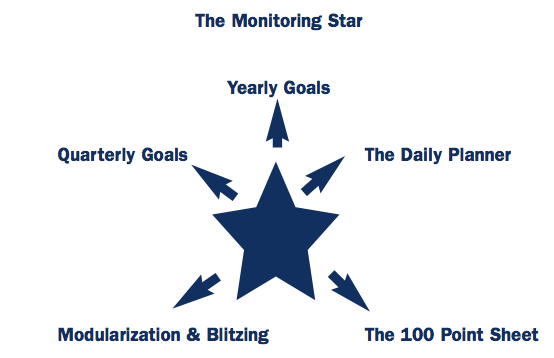This time when the phone rang, I knew who was calling. Benjamin was punctual and anxious to get started. During our last session, Ben and I had covered two of the five points in the Monitoring Star. We had discussed, in detail, Yearly Goals and Quarterly Goals. Now it was time to discuss the final three points of the star: The Daily Planner; Modularization & Blitzing; and The 100 Point Sheet. Once we finished with all five major topics, Ben would possess the necessary structure and monitoring systems so that he would be well on his way to achieving his recruiting goals.

Ben began with a series of questions. How was he going to complete all of the calls we had determined he needed to make? How was he going to stay on track? How would he remember everything? I stopped him. First things first. At the beginning there is the daily plan.
The Daily Planner
I believe in daily planners because they work. I like the paper format, but am fine with the electronic format as well as long as they are founded on multi-tasking and are modularized.
Multi-Task Foundation
When I say that the planner should be founded on multi-tasking, I mean that I want to encourage my client recruiters to move freely within the call depending on how the call naturally unfolds. I learned long ago that sometimes marketing turns into recruiting and recruiting turns into marketing. And so, my planner is multi-task oriented which enables my client recruiters to take the most out of each call
At least five (5) possibilities exist on each call: You can Direct Market, Indirect Market, Direct Recruit, Indirect Recruit and Information Gather. This allows you to get something positive out of each call, which in turn encourages you to rush right into your next call. It’s all a cascade of successes that further anchors in your subconscious mind that this business is a lot of fun! Not only does this work, but the top recruiters found this out a long time ago, and that’s why they make this business look so easy. As a traveling trainer, I would sit at their desks and take notes. Let me tell you this, top recruiters are masters of multi-tasking. And for them, this business is a whole lot of fun!
Quarterly Format
My planners are based on a three-month period – thirteen (13) weeks. Each planner has one hundred and thirty-two (132) pages – or enough for two pages (four sides) per day for the 64-66 workdays in each quarter. As a client, Ben will receive four (4) planners each year.
I have constructed my planner so that ninety-four (94) calls per day are possible. My recommendation, however, is to pre-plan about 6-10 calls in each “hour” block to allow yourself free time within each hour to be reactive (call backs, suggestion calls, new ideas, etc.). It is more fun that way—also more creative and more profitable!
Every day at planning time you will plan for your next day. During this hour (sometimes longer) you will enter into the planner what you will be doing the following day. This function is CRITICAL to your success!
Modularization & Blitzing
The planner will allow you to break your day into hour modules and blitz during each of those one-hour blocks of time. Industrial Engineers tell us that human beings work more efficiently when their workloads are broken down into small blocks of time—as little as 15-minute blocks of time. For our purposes, I like one-hour modules so my planner has eight (8) of those to correspond to a daily eight (8) hour working schedule.
Compared to average billers, top billers have very large marketplaces. It’s not unusual for them to make 75 marketing ‘connect’ calls per day. That is a lot and, because of that, I very rarely teach recruiters to make that many calls. But I do think that a marketplace of 1,500 company contacts is do-able for anyone. With Ben we delimited a marketplace of 1,500 individual hiring managers to contact on a quarterly basis. That works out to 500 per month; 125 per week; 25 per day; or 12.5 per morning and 12.5 per afternoon. This number was a concern of Ben’s. This is where Modularization enters the picture to help us.
Here is the basic Modularized Day that I gave to Ben:
The Marshall Plan “MODULARIZED DAY” © 2010
Modularized Day with Seven “Action” Modules
|
Time |
Module |
Activity |
|
7:00 – 8:00 | Drive to work, arrive, pour coffee, etc. | |
|
8:00 – 8:30 |
I | Morning Meeting |
|
8:30 – 9:00 |
II | 2-3 Friendly Phone Calls that lead to money |
|
9:00 – 10:00 |
III | 10 Attempts = 5 Presentations |
|
10:00 – 11:00 |
IV | 10 Attempts = 5 Presentations |
|
11:00 – 11:30 |
V | 5 Attempts = 2.5 Presentations |
|
11:30 – Noon |
VI | Morning Paperwork/Computer entry |
|
Noon – 1:00 |
VII | Lunch – Out Of The Office |
|
1:00 – 2:00 |
VIII | 10 Attempts = 5 Presentations |
|
2:00 – 3:00 |
IX | 10 Attempts = 5 Presentations |
|
3:00 – 3:30 |
X | 5 Attempts = 2.5 Presentations |
|
3:30 – 4:00 |
XI | Afternoon Paperwork/Computer entry |
|
4:00 – 5:00 |
XII | Plan for tomorrow |
|
Night Home Calls |
XIII | 2-4 Planned Calls |
Four (4) Special Notes:
- Rhythm and Production will increase during the four morning (bold) and three afternoon (bold) “Action” Modules.
- All “Presentation Calls” should include Multi-tasking (when possible) to increase the success of each Action Call. Five multi-tasking options are possible on each call: Direct Marketing; Indirect Marketing; Direct Recruiting; Indirect Recruiting; and Information Gathering.
- Don’t plan too tightly within each module. Allow for reactive “slush” time (call backs, last minute preps, handling emergencies, etc.).
- Once the individual module time has expired, promptly move on to the next module.
So now we had our outline. It would flux with the type of changing activity (searches, preps, debriefs, etc.) that Ben had on his desk, but we wanted to stay as close as possible to this framework.
So Ben agreed that he could do this on a daily basis. But, since he probably wouldn’t make daily placements, how would he know if he was staying on track; if he was going to be successful?
Monitoring Devices and Call Accounting Systems
Ahhh, the many call accounting systems and the latest software versions thereof. Which one should you choose? Well, I am here to tell you to not choose any of them. And don’t tell me about the efficacy of the most recent version of a call accounting system that measures time on the phone.
First of all, they usually monitor only outbound calls, not incoming calls. But that being said, and more importantly, they don’t measure ‘effectiveness’ of the phone call. A bunch of one-minute phone calls don’t equal success. In the immortal words of UCLA basketball coach, John Wooden, “Never mistake activity for achievement.” And besides that, we want to reach that magical 3-5 minute time window where rapport is established.
There was only one monitoring device for Ben…and that was the classic 100 Point Sheet.
The 100 Point Sheet*
This monitoring device was created by a recruiting firm owner who possessed advanced college degrees in mathematics and computer science and wanted to objectively measure a very subjective business. He wanted to insure that his recruiters would ultimately be successful. He came up with this method that awarded more points for the activities that were ‘central’ to making a placement. A marketing attempt was given 1 point. A marketing presentation was given 1 point. Matching calls (where a job order pre-existed) were given 3 points to either the Hiring Manager or the Candidate. Send Outs were awarded 15 points, etc. This formula has been modified over the years, but the intent is still the same.
Here is a link to the modified Weekly 100 Point Sheet that I sent to Ben.
The 100 Point Sheet is designed to show you where you are at any given point during the day. For instance, if it is lunchtime and you have 50 points or more, you are doing well. If, on the other hand, you only have 25 points, then you didn’t have a good morning and you had better kick it up a notch in the afternoon to make up the deficit. The idea is that if you attain over 100 points per day (and your ratios are normal) then you will make placements. If not, then you won’t. Simple as that! One of the obstacles that we all face in this business is that we sometimes get so caught up in the ancillary tasks during our day (long strategy sessions, figuring out who to call next, entering information into our computer databases, chasing the same person all day long, etc.) that we miss the tasks that are central to making a placement, i.e., Action Calls and Send Outs.
This sheet also allows you to feel rewarded even when you didn’t make a placement (not usually a daily occurrence in recruitment) as long as you reach and/or exceed the century mark. Like any good map, this 100 point sheet forces you to stay on target. I promise you it works! But it does measure performance; so don’t use it if you are afraid to be measured. But without benchmarks, your job becomes more like a game of golf with no scorecard or a game of football with no final score. That’s pointless, isn’t it! In the words of one of our legendary managers, “Inspect what you expect.”
*(for more information on The 100 Point Sheet, see TFL, January 2010, “2010…the Year to Continue ‘Adaptability,’, p. 5)
The 100 Point Sheet Key
The definitions vary by recruitment firm, but here is the Key to the 100 Point Sheet that I sent to Ben.
Now It’s Time for Execution
So now we have in place the plan for each day (The Daily Planner), the structure for each day (Modularization & Blitzing) and the evaluation scheme for that same day (The 100 Point Sheet). Now it’s time for Ben to start executing the plan. No knowledge deficiencies now. The tools are in his hands and, by extension, in yours. Remember the words of Goethe, “Whatever you do, or dream you can, begin it. Boldness has genius and power and magic in it.”
Next week, “The Phone Rang…” series will cover “How to Acquire the Right Attitude.” Until then, good hunting…
“The Phone Rang…” by Bob Marshall is a series that defines what we, as recruiters, do for a living. This article series ran in The Fordyce Letter over the past year and we are proud to bring you the series online. To subscribe to the print edition of The Fordyce Letter, click here.
